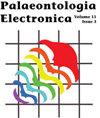根据相关的齿列化石估算新第三纪巨噬片状鲨鱼(Carcharodon和Otodus)的体长
IF 1.5
4区 地球科学
Q1 Earth and Planetary Sciences
引用次数: 15
摘要
巨齿鲨被广泛认为是有史以来最大的大型食肉鲨鱼;然而,尽管进行了一个多世纪的研究,其规模仍存在争议。大白鲨Carcharodon carcharias被认为是与已灭绝的巨齿鲨最相似的生态物种,也是迄今为止所有体型估计的基础。最广泛接受和应用的估计巨齿龙体型的方法是基于C.carcharias牙冠高度和全身长度之间的线性关系。然而,当将该方法应用于巨齿龙(UF-VP-311000)的相关牙列时,该个体的估计值在11.4至41.1m之间。这些变化很大的估计值显示出一种不同的模式,其中前牙的估计值低于后牙。因此,以前基于巨齿龙体型估计的古生态学分析可能会被误解。在此,我们描述了一种基于相关化石牙列的总牙冠宽度的新方法,该方法减轻了与不同牙齿位置相关的可变性。该方法假设生态和分类学相关化石和现代物种的冠宽与体长之比直接成比例。估计了11个个体的总体长,代表了5个Lamuniform物种:巨齿龙、圆齿龙、卡沙隆、哈氏卡沙隆和哈斯塔利卡沙隆。该方法是对已知最大的巨齿龙孤立上齿进行推断的,得出的最大体长估计为20米。Victor J.Perez。佛罗里达自然历史博物馆古脊椎动物系,1659 Museum Rd.,Gainesville,Florida 32611,美国佛罗里达大学地质科学系,241 Williamson Hall,PO Box 112120,Gainenville,佛罗里达32611,和Calvert海洋博物馆古生物系,Solomons,Maryland 20688Victor.Perez@calvertcountymd.gov罗尼·M·莱德。美国佛罗里达州盖恩斯维尔博物馆路1659号佛罗里达自然历史博物馆古脊椎动物系,邮编:32611,以及莱比锡市自然历史博物馆,Lortzingstraße PEREZ,LEDER和BADOUT:估计LAMNIFORM BODY SIZE 2 304105,德国莱比锡。ronnymaik.leder@leipzig.deTeddy Badaut。独立研究员,法国Thoirette。kieffer_stirlling@hotmail.fr本文章由计算机程序翻译,如有差异,请以英文原文为准。
Body length estimation of Neogene macrophagous lamniform sharks (Carcharodon and Otodus) derived from associated fossil dentitions
The megatooth shark, Otodus megalodon, is widely accepted as the largest macrophagous shark that ever lived; and yet, despite over a century of research, its size is still debated. The great white shark, Carcharodon carcharias, is regarded as the best living ecological analog to the extinct megatooth shark and has been the basis for all body length estimates to date. The most widely accepted and applied method for estimating body size of O. megalodon was based upon a linear relationship between tooth crown height and total body length in C. carcharias. However, when applying this method to an associated dentition of O. megalodon (UF-VP-311000), the estimates for this single individual ranged from 11.4 to 41.1 m. These widely variable estimates showed a distinct pattern, in which anterior teeth resulted in lower estimates than posterior teeth. Consequently, previous paleoecological analyses based on body size estimates of O. megalodon may be subject to misinterpretation. Herein, we describe a novel method based on the summed crown width of associated fossil dentitions, which mitigates the variability associated with different tooth positions. The method assumes direct proportionality between the ratio of summed crown width to body length in ecologically and taxonomically related fossil and modern species. Total body lengths were estimated from 11 individuals, representing five lamniform species: Otodus megalodon, Otodus chubutensis, Carcharodon carcharias, Carcharodon hubbelli, and Carcharodon hastalis. The method was extrapolated for the largest known isolated upper tooth of O. megalodon, resulting in a maximum body length estimate of 20 m. Victor J. Perez. Department of Vertebrate Paleontology, Florida Museum of Natural History, 1659 Museum Rd., Gainesville, Florida 32611, USA and Department of Geological Sciences, University of Florida, 241 Williamson Hall, PO Box 112120, Gainesville, Florida 32611, USA and Department of Paleontology, Calvert Marine Museum, Solomons, Maryland 20688, USA Victor.Perez@calvertcountymd.gov Ronny M. Leder. Department of Vertebrate Paleontology, Florida Museum of Natural History, 1659 Museum Rd., Gainesville, Florida 32611, USA and Natural History Museum City of Leipzig, Lortzingstraße PEREZ, LEDER, & BADAUT: ESTIMATING LAMNIFORM BODY SIZE 2 3, 04105 Leipzig, Germany. ronnymaik.leder@leipzig.de Teddy Badaut. Independent Researcher, Thoirette, France. kieffer_stirlling@hotmail.fr
求助全文
通过发布文献求助,成功后即可免费获取论文全文。
去求助
来源期刊

Palaeontologia Electronica
地学-古生物学
CiteScore
3.60
自引率
0.00%
发文量
20
审稿时长
>12 weeks
期刊介绍:
Founded in 1997, Palaeontologia Electronica (PE) is the longest running open-access, peer-reviewed electronic journal and covers all aspects of palaeontology. PE uses an external double-blind peer review system for all manuscripts. Copyright of scientific papers is held by one of the three sponsoring professional societies at the author''s choice. Reviews, commentaries, and other material is placed in the public domain. PE papers comply with regulations for taxonomic nomenclature established in the International Code of Zoological Nomenclature and the International Code of Nomenclature for Algae, Fungi, and Plants.
 求助内容:
求助内容: 应助结果提醒方式:
应助结果提醒方式:


